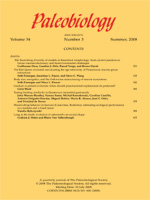Ceratopsid dinosaurs traditionally have been restored with sprawling forelimbs and were considered unable to run at high speeds. An alternative view restores the ceratopsids as rhinoceros-like with parasagittal forelimb kinematics and the ability to run faster than extant elephants. Several anatomical difficulties concerning the mounting of ceratopsid skeletons with nearly parasagittal forelimbs stem not from the forelimb itself, but from errors in rib and vertebral articulation. Matching a skeletal restoration to a probable ceratopsid trackway shows that the hands were placed directly beneath the glenoids, and that manual impressions were directed laterally, not medially as in sprawling reptiles. Pedal impressions in trackways are medial to the manual impressions, owing to the slightly averted elbow and to the asymmetrical distal femoral condyles, which directed the crus slightly medially. The limbs of ceratopsians of all sizes display substantial joint flexure, strongly indicating that the elephantine forelimb posture that has sometimes been suggested as the alternative to a sprawling posture is erroneous. The articular surfaces of uncrushed ceratopsian scapulocoracoids and forelimb joints confirm that the forelimb operated in a near-parasagittal plane with the elbows only slightly averted. The maximal running speed of even the largest ceratopsids is inferred to have significantly exceeded that of elephants and was probably broadly similar to that of rhinos.
How to translate text using browser tools
1 September 2000
Forelimb posture in neoceratopsian dinosaurs: implications for gait and locomotion
Gregory S. Paul,
Per Christiansen
ACCESS THE FULL ARTICLE

Paleobiology
Vol. 26 • No. 3
September 2000
Vol. 26 • No. 3
September 2000




